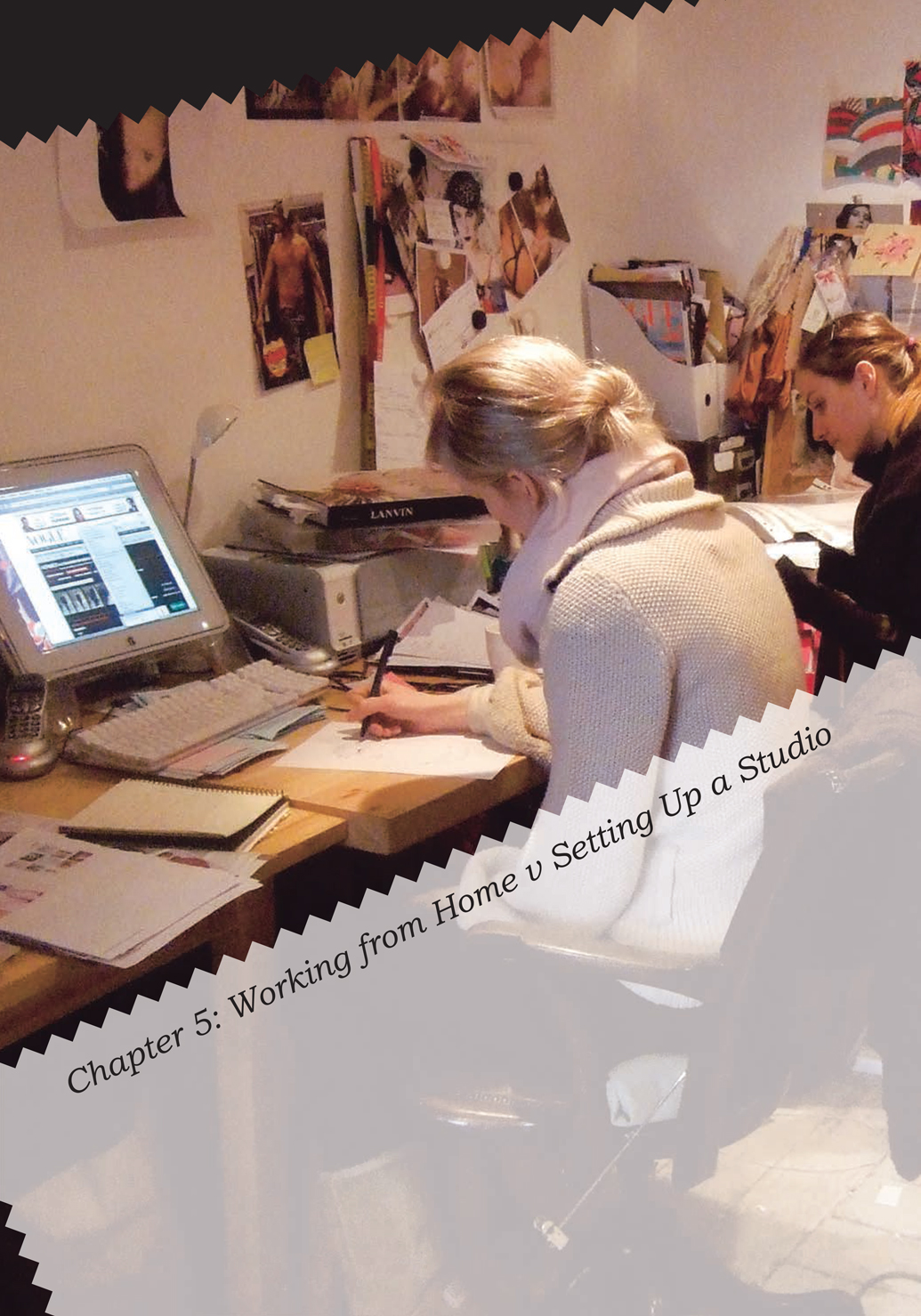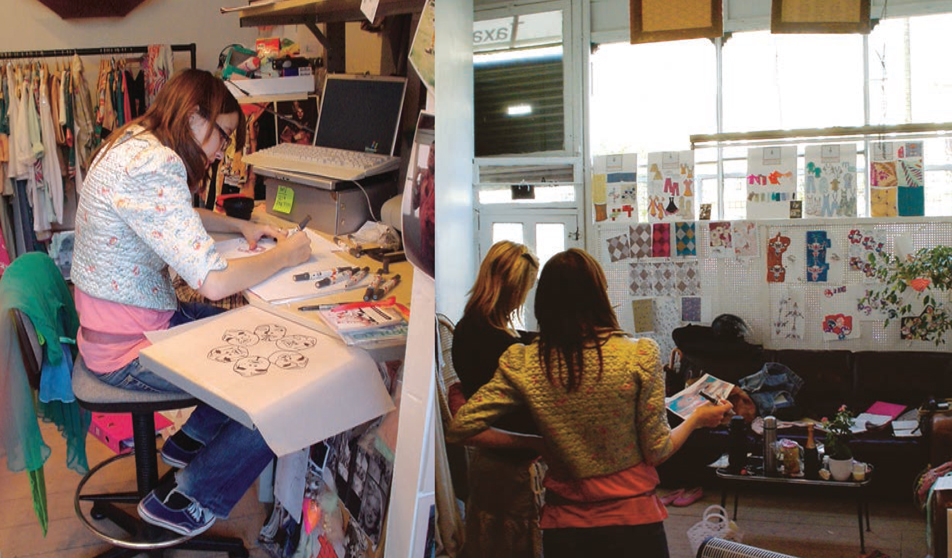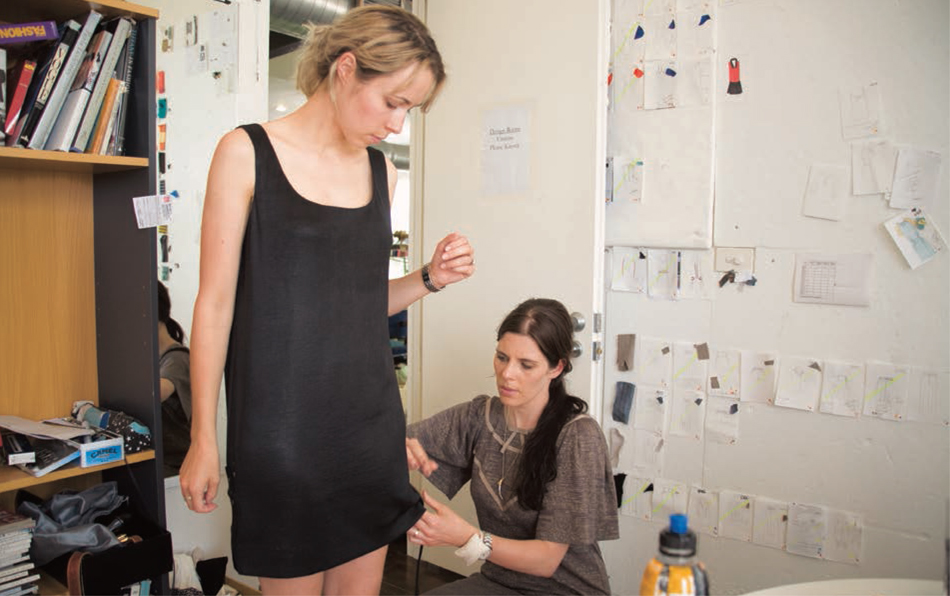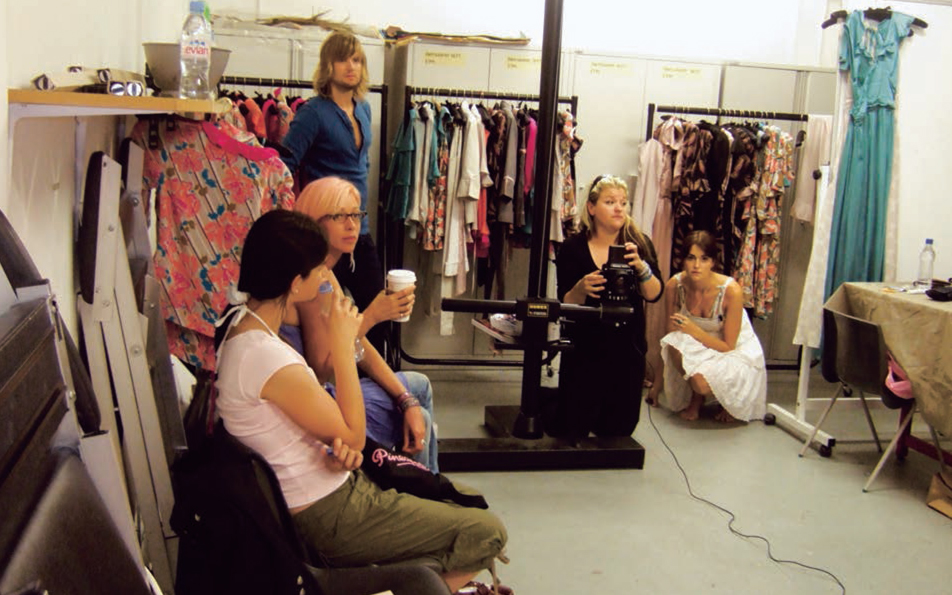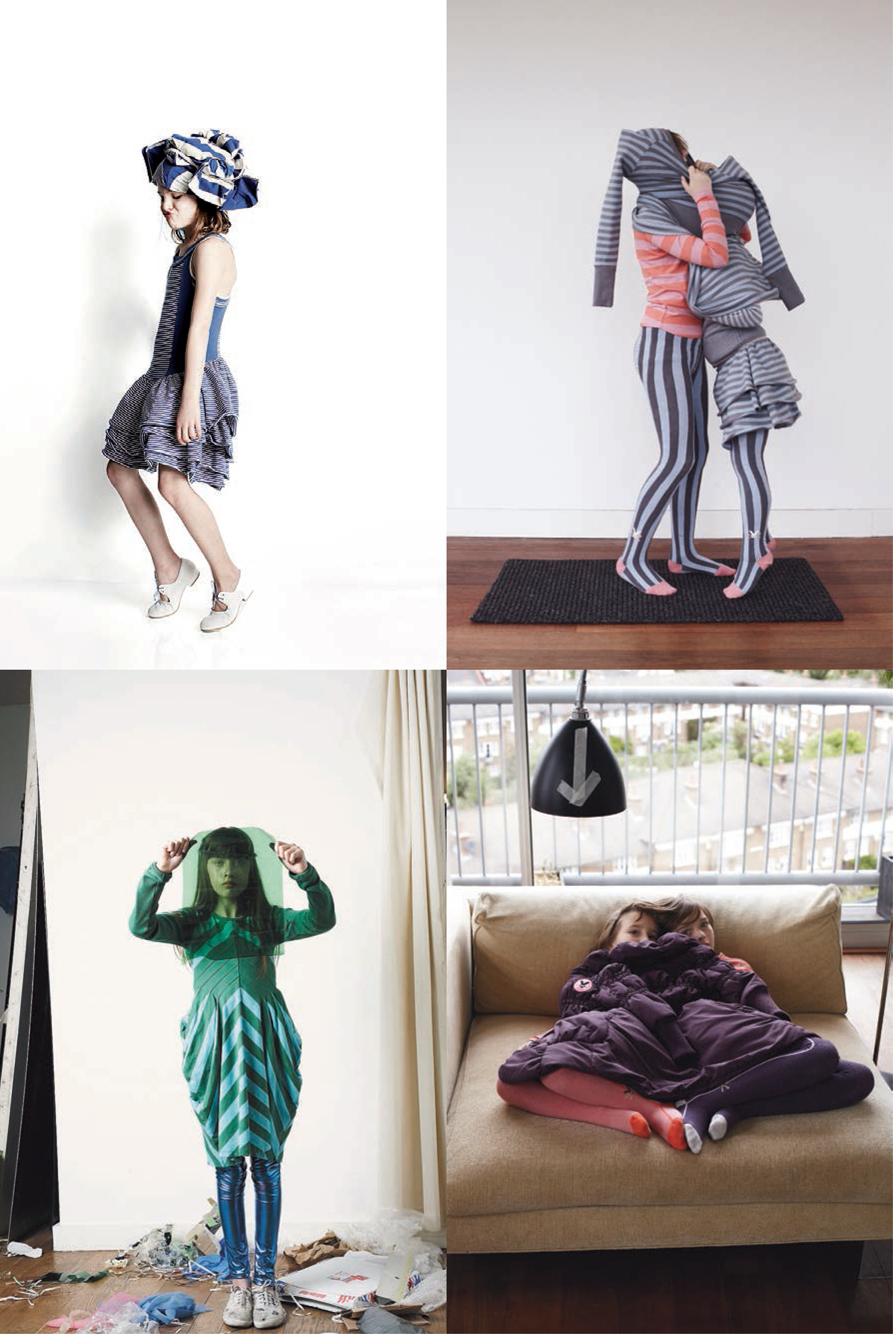Designers at work
Establishing a good and practical working environment is essential to success. While many aspiring designers start off in their bedrooms for practical and financial reasons, there are still certain requirements for a work space. This chapter looks at the pros and cons of working at home against the cost of taking up a studio and examines how your work space may be perceived by buyers and press.
Working From Home
When starting out, keeping costs to a minimum is important to the financial stability of the business. Working from home can be a good way to save money. You will, however, need to weigh up the pros and cons to be sure that it won’t actually cost your business in the long run.
Pros and Cons
![]()
Pros
Not having to commute; saving on rent; taking calls in your pajamas; getting up at 8:30 am and still being at work for 9:00 am.
Cons
The office can easily overflow into your living space; it can be difficult to “switch off” during evenings and weekends; there can be distractions from housemates.
![]()
Do You Have the Right Space?
If you have some space at home from which to work, you need to establish if it is the right space for you.
Work out how much space you will need
This will depend on the type of fashion business you are setting up. If you will be cutting your own patterns and sampling your own product you will need a lot of flat work space. If you will be selling your product directly through your website you will need to have enough storage space for your stock without infringing on the rest of the household. If you will be outsourcing everything, a desk with the bare essentials will suffice.
Allocate a dedicated work space
You should try to allocate a permanent space to your business; ideally a room rather than just a corner. A separate room will reduce the risk of distraction. You should be able to separate your work life from your personal life as much as possible and to shut the door to either as and when required.
Keep it flexible
Will your allocated space give you the flexibility you need? At times it may need to be a design studio, sales showroom, warehouse, or distribution center. The more you can move things around and make the space suit the activity, the better. When you have designated a space for your home office, take measurements so you know exactly how much space you have to play with. Sketch a layout of the room and map out where the furniture and equipment will go.
Get the lighting right
Running your own business will require high levels of energy and enthusiasm. There is nothing more likely to sap these than a badly lit work environment. Bad lighting can cause headaches, eye strain, and fatigue. Choose a space with windows that can provide some natural light—you will need good lighting to choose color palettes for your collections. Lighting the wall behind a computer monitor can reduce eye strain, while a good adjustable desk lamp can provide light in a range of different situations.
Make the right first impression
You work environment says a great deal about you and your business. Giving potential clients a tour of your entire property is not the best starting point so try to keep your office confined to an easily accessible space near the entrance. If your work environment gives the wrong impression, try meeting outside of home as much as possible, and look into hiring meeting or showroom space when needed.
Making Use of the Space
No matter how good a work space you have, you need to make the best use of it.
Be logical
Try to create a work space that will maximize your efficiency and work flow. Know where everything is and keep key functions like phones, computers, and sewing machines in your primary work space.
Be tidy
You will need to switch between job functions several times a day, so keep your work space organized. Know where everything is at all times. Labeling can help with this. At the end of each day leave the space ready for the beginning of the next.
Remember storage
Take time to think about your storage requirements. Shelves mounted on the wall provide useful storage for home office supplies and files and do not take up any floor space. You will also require drawers for trims, buttons, and fastenings, and clothes rails for your samples.
Make sure you have a designated space that will allow you to be both creative and productive. Your surroundings should inspire you
Think multi-functional
When space is an issue, buy furniture and equipment that can perform different functions. This could include an all-in-one printer, scanner, and copier, or a storage cabinet that also provides a work surface. Furniture that can be rolled out of the way is also useful.
Keep trim
Keep any unnecessary items away from your work space. This might include anything likely to distract you (such as televisions) and stop you from working efficiently. However, you will be working in a creative industry, so don’t deprive yourself of things that will help to stimulate the creative juices.
The Practicalities
There are certain things to take into account in order to make the arrangement workable.
Legal and insurance
You are legally required to notify your landlord or mortgage lender that you will be working from home, as your property may now be considered semi-commercial, rendering your initial mortgage agreement invalid. There are special semi-commercial mortgages, and your lender may require you to move to one of these. Check your home insurance, as it probably doesn’t cover working from home—if you expect to receive business visitors then you will probably need additional cover. Standard working from home insurance coverage can include:
![]() Business contents
Business contents
![]() Employers’, public, and product liability
Employers’, public, and product liability
![]() Legal expenses
Legal expenses
![]() Business interruption protection.
Business interruption protection.
Working from home optional extras can include:
![]() Buildings insurance—accidental damage cover for your home business area and your home
Buildings insurance—accidental damage cover for your home business area and your home
![]() Home contents insurance—accidental damage cover for your home contents
Home contents insurance—accidental damage cover for your home contents
![]() Personal possessions—peace of mind if you take personal items away from home
Personal possessions—peace of mind if you take personal items away from home
![]() “All risks” on business equipment—cover for accidental loss or damage of office equipment
“All risks” on business equipment—cover for accidental loss or damage of office equipment
![]() Computer breakdown—covers breakdown and failure of computer equipment, or loss/damage to computer records.
Computer breakdown—covers breakdown and failure of computer equipment, or loss/damage to computer records.
Source: www.theaa.com
It is also worth ensuring that any particularly expensive items of equipment or product are covered. You may be able to include some or all of these in your home contents insurance. You may also want to increase your security measures if there is a great deal of expensive equipment or merchandise being stored. The more security you have, the lower your monthly premium will be.
Health and safety
You will be legally responsible for your own health and safety and that of any employees or visitors to your premises. Study the legislation. There are some simple things you can do to make your space a good one to work in. Make sure your workstation is comfortable, and that any wires or cabling are located in a safe place (to avoid tripping). Take the time to undertake a risk assessment of the premises and identify any potential hazards.
Remember:
Make sure you comply with the law regarding insurance and health and safety regulations. Keep home life and work life separate. If you are living with others, make sure they know when and where you work.
Working from a Studio/Workshop
Taking up a studio, office, or workshop space is a big step. However, at some point you will probably need to find yourself a space away from home that will allow you to conduct your business effectively.
Pros and Cons
![]()
Pros
A flexible work environment; separation of work and home life; a professional business address.
Cons
The cost implications of running the studio; the financial commitment of a lease.
![]()
Identify Your Requirements
Before you start looking for potential space, make a list of all your requirements. This streamlines the hunt for premises. The key points will be:
Function
Make a list of the key activities of your business. Your prospective space must allow all of these activities to take place. If it is a small space, does it give you the flexibility to move things around to create a different look when customers call?
Location
Think about:
![]() The length of commute from your home to the studio or to your clients or suppliers
The length of commute from your home to the studio or to your clients or suppliers
![]() The journey your customers will have to make
The journey your customers will have to make
![]() Transport links and access to parking.
Transport links and access to parking.
Cost
Set a realistic budget and stick to it. It’s not just the rent or mortgage you will need to think about, but also:
![]() Set-up costs for getting the space how you need it to look
Set-up costs for getting the space how you need it to look
![]() Additional property costs: business rates, service charges and insurance, security deposit
Additional property costs: business rates, service charges and insurance, security deposit
![]() Day-to-day running costs: gas, water, electricity, telephone, internet, and cleaning/maintenance.
Day-to-day running costs: gas, water, electricity, telephone, internet, and cleaning/maintenance.
Size
Keep things to a minimum. However, don’t go too small, and make sure you have enough space to accommodate potential new employees or casual labor as and when required.
Services
Think about the services you will need: toilets and kitchen facilities.
Designer Karen Walker at work in her studio
Isolation
Running your own business can be lonely, so think carefully before choosing a location that cuts you off too much from the outside world, unless that’s what inspires you the most.
Security
The most affordable studios are often located in slightly less desirable areas. Think about safety and security.
Types of Space
There are many different types of work space available. Decide which one will suit you best.
Individual work spaces
Often owned by private landlords, these can range from retail premises to offices or industrial workshops. There is often room for negotiation on rent and conditions of the lease.
Professionally managed studios
The monthly fee usually includes all studio expenses from rent, business rates and services to utilities. You will usually be surrounded by creative companies— this can help with inspiration, networking, and finding potential suppliers. The security is usually good and administrative functions may be thrown in. Rent, however, tends to be a little higher and you’re less likely to find a bargain.
Shared studios
If you have found a fantastic location that ticks all your boxes but is just a bit too big and expensive, you could look for similar businesses to share the space with you. This is sometimes called a “co-operative.” Have an attorney draw up a contract for each tenant and draw up a set of studio rules.
Flexibility is key in finding the right space. You may need to undertake a number of activities ranging from design to buying appointments to photo shoots, as shown above
Finding a Studio
There are many ways to find a studio.
![]() Word of mouth: Recommendations from friends and family or people already in the industry.
Word of mouth: Recommendations from friends and family or people already in the industry.
![]() Business support agencies: Enterprise agencies’ listings.
Business support agencies: Enterprise agencies’ listings.
![]() Real estate agents: Estate agents’ commercial listings.
Real estate agents: Estate agents’ commercial listings.
![]() Internet: Information from agents to business organizations and personal postings.
Internet: Information from agents to business organizations and personal postings.
![]() Managed studios: Managed premises will often have a waiting list that you can put your name down on.
Managed studios: Managed premises will often have a waiting list that you can put your name down on.
![]() Advertising: Ads in local stores and on e-bulletin boards for relevant fashion sites.
Advertising: Ads in local stores and on e-bulletin boards for relevant fashion sites.
![]() Taking a stroll: Seeing “for rent” signs on commercial properties; talking to local business owners.
Taking a stroll: Seeing “for rent” signs on commercial properties; talking to local business owners.
Getting the Space
Once you have found the ideal space, before you put pen to paper and sign the contract, there are some considerations.
![]() Negotiate with your landlord: can you get a rent reduction or arrange a rent-free period while setting up the studio?
Negotiate with your landlord: can you get a rent reduction or arrange a rent-free period while setting up the studio?
![]() Check out your landlord. It’s a good idea to speak to other tenants.
Check out your landlord. It’s a good idea to speak to other tenants.
![]() Get your solicitor to check over the rental agreement. How binding is the contract and for how long are you expected to sign? Can you make it more favorable to you?
Get your solicitor to check over the rental agreement. How binding is the contract and for how long are you expected to sign? Can you make it more favorable to you?
![]() Check whether you are responsible for service charges, power, water, and so on.
Check whether you are responsible for service charges, power, water, and so on.
Do your homework and get an idea of the rental values of different types of property in the area.
Deborah Medhurst established the childrenswear label no added sugar in 2001 after a colorful career in the London club scene running Puscha—all night club parties held in glamorous locations for London fashionistas. There were “ten years of wonderful hedonism. Then I got pregnant.” Deborah set up no added sugar as she felt the childrenswear market lacked “wit, bold color, and originality. At start up I was purely looking to have some fun, keep my business-head busy, and make some pin money.” Deborah initially produced 15 different slogan print T-shirt samples and drove across London showing them to her wishlist of stores. The response to the small range was overwhelming—approximately 300 pieces were ordered and Deborah’s gentle pastime quickly became “an all-consuming new baby!” Within three months Deborah added a range of playsuits and a further nine months on she extended the sizing range up to five years old.
One of the key successes for no added sugar has been the readily identifiable signature and attitude that the brand exudes. “It’s a saturated market. Any designer will need to have a clear identity and an understanding of their market. Product is always king; without a good product there is no business.” For the first four years they mainly produced T-shirts; it wasn’t until fall/winter 2007 that they launched their first seasonal line. Now no added sugar offers full collections for boys and girls from three months up to 12 years.
The first ranges were produced in England. However, within the first year as volumes increased manufacturing was moved to Portugal where 70 percent of the range is still produced today. While Deborah says “I am not a great networker and in truth probably avoid it,” she does recognize that contacts have proven important in the development of the label. “One key contact was our neighbor, Philip Start of Start Boutique in London, who generously provided us with a great manufacturing contact that we still use today.”
To get things moving Deborah approached a bank to borrow money, but they wouldn’t give her a loan so she had to look to family members to borrow £8,000. Deborah believes it’s important to “hold on to your business. We have had many opportunities to take investment over the years but held back.” She does recognize that “when the time is right to release the potential of the brand it may involve investment,” but that it’s important “to be clear about your goal and how you intend to get there and be totally comfortable who you partner with.”
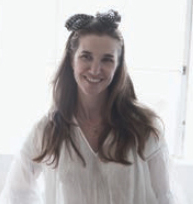
As well as wholesaling no added sugar also offered a small catalog service. Not too long after Deborah set up the online store, and without any promotion “the mail order business tripled overnight.” The online shop remains a crucial part of the business today. Deborah says, “We love it still for being in touch with what the customer likes to buy (store buyers can get it wrong and tend to play safe) and obviously the margin is considerably more favorable (than wholesale) which allows us to develop our marketing campaigns.” Currently no added sugar sell direct on their webshop and supply hundreds of stockists worldwide. The strategy moving forward is to open their own store, with a view to building “an even closer relationship with our customer.”
Since the inception of the business they have had no real PR drive. All press they have received has been from journalists/publications approaching them directly. Deborah says “coming from a party business which is heavily about promotion we felt pretty able to handle our own marketing and I still control this today.” However she felt that the online/direct business required a different skill-set and therefore they “initially employed an external marketing company to manage this but now have brought this in house.”
Deborah believes that to be successful in running your own label you need to be passionate, intuitive, confident, positive, approachable, individual, cost-conscious, and work extremely hard. She believes that a lot of no added sugar’s success has come from the originality and quality of the product, as well as listening to their instincts and allowing themselves to take risks where needed. Valuing the customer is also a major factor.
no added sugar is a cool, playful childrenswear line with an attitude

